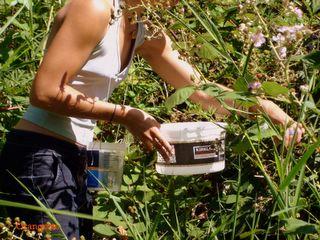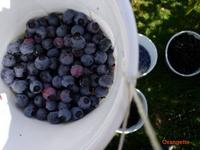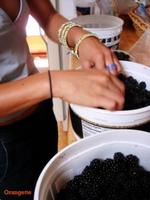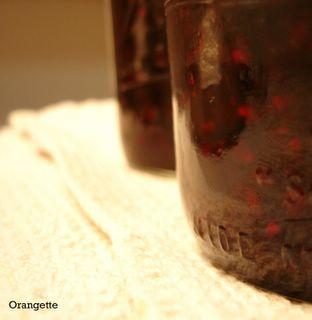On picking, prattling on, and preserving
“Forget our walk; I’ve got a better idea,” Kate announced with a little squeal. “There are blackberries everywhere. Why don’t you come over and we’ll go berry-picking? We’ll be like those hunter-gatherer women in National Geographic, stooped over in the bushes, foraging, chatting—but with clothes! I’ll even lend you a sunhat.”
Some women join quilting circles; others stitch ‘n bitch. Some walk together; some run together; and a few gossip over golf. Others meet for cocktails, or there’s tea and twittering. But as for me, if given the option, I prefer to prattle with fellow females over something a bit more old-school, or rather, primeval. The trappings of modernity are nice, but when the call comes, sign me up for an afternoon of foraging and flitting about the garden with a good girlfriend and a thicket of blackberry bushes to tear at our hands.

So it was that a few days ago I slipped on a pair of dirty jeans, sped fifteen minutes east of Seattle, and joined Kate in laying waste to her parents’ backyard. She greeted me at the door and, being the master of all things fishnets to frump, quickly outfitted me for the task at hand. Offering me an empty plastic yogurt tub, she instructed me to hang it from my neck
and joined Kate in laying waste to her parents’ backyard. She greeted me at the door and, being the master of all things fishnets to frump, quickly outfitted me for the task at hand. Offering me an empty plastic yogurt tub, she instructed me to hang it from my neck by a kitchen-twine yoke, and then she led me to the family’s communal hat-rack, where she handed me a floppy blue sun-hat two sizes too small. Needless to say, I was nobody’s centerfold, but minutes later, in the bushes down by the water, telling juicy stories through the leaves, with the sun hot on my back, blackberry juice under my fingernails, and my wrists red and bramble-bitten, I couldn’t have been
by a kitchen-twine yoke, and then she led me to the family’s communal hat-rack, where she handed me a floppy blue sun-hat two sizes too small. Needless to say, I was nobody’s centerfold, but minutes later, in the bushes down by the water, telling juicy stories through the leaves, with the sun hot on my back, blackberry juice under my fingernails, and my wrists red and bramble-bitten, I couldn’t have been happier. We dished our way through to the blueberry bushes, pausing only for a quick shriek or two when I nearly fell into a hard-to-see hole, but no matter—I didn’t spill a berry. In fact, there were plenty left for Kate to steal—sneaking them into her bucket in mid-sentence—and for carrying home later and stewing into a silky purple jam.
happier. We dished our way through to the blueberry bushes, pausing only for a quick shriek or two when I nearly fell into a hard-to-see hole, but no matter—I didn’t spill a berry. In fact, there were plenty left for Kate to steal—sneaking them into her bucket in mid-sentence—and for carrying home later and stewing into a silky purple jam.
I suppose we could opt next time for something a bit more dainty, perhaps sans sunscreen, sun-hats, and stains. Tea and scones sounds a lot more tempting, anyway, now that I’ve got a cupboard full of blackberry jam. But something tells me that a few days will find the berry bushes again full and heavy, the green vines dripping with beans, the plums nearly falling from their stems, and the two of us babbling over full buckets.
Italian Family Jam
Adapted from Bruna and Margot

A few years ago, Kate’s older sister Margot spent a year and a half in Italy, where she befriended—and was all but adopted by—a local couple. Aside from finding a good bicycling partner in the husband, she also found a very skilled kitchen companion in his wife Bruna, who offered up this classic recipe for plain-and-simple Italian country jam. Margot has since sent myriad different fruits through its formula—apricots to peaches, raspberries, strawberries, blueberries, and blackberries—all with tooth-achingly good results. On an average weekend morning when the whole family is at home, they’ll go through a good jar of the stuff on toast, waffles, pancakes, or eager fingers.
These days, it seems as though fancy jams are everywhere, with a new herb or spice thrown in every day. I love the idea of so much nuance and complexity, but in all honesty, I don’t often find myself itching to try the stuff. When it comes to jam, I want nothing fancy—just fruit, a squeeze of lemon, and enough sugar to set the jar sparkling. I want a clean, concentrated flavor, the essence of the fruit heightened, undisguised. And luckily, this sort of jam is astoundingly easy to make at home—no fussing with packets of pectin, no cheesecloth, no enormous pots and fears of contamination. Bruna’s method is quick and confidence-inspiring, a process that’s both immensely sensual and appealing practical. The same goes for the finished product. Dress it up or play it down, however you choose: spoon it over homemade ice cream, dot it daintily on a scone, or give it a British accent by layering it into a trifle; pair it with nut butter on homemade bread, fold it into plain yogurt, or hide it inside a cake. But first, call your girlfriends, and gather ye berries while ye may.
1 kg (2.2 pounds) fresh fruit, preferably berries or stone fruits (if using the latter, pit and cut into chunks, and if using peaches or nectarines, peel them as well)
½ kg (1 pound) granulated sugar, or to taste (if fruit is perfectly ripe, you may need a bit less)
Juice of ½ lemon
Combine the fruit, sugar, and lemon juice in a large pot or Dutch oven, and let macerate at room temperature for two hours, stirring occasionally.
While the fruit is resting, prepare the jars. Preheat the oven to 225 degrees Fahrenheit, and wash a half-dozen 8-ounce jam jars (the type with two-part sealable lids: a flat disk and a ring) under hot, soapy water. Place the jars—but not the lids—in the oven. Wash the lids under hot, soapy water, and place them on a clean dish towel to dry. The jars will need to stay in the oven for at least 20 minutes.
Place the pot containing the fruit over medium-high heat, and bring the mixture to a boil. Boil the jam for 30 minutes, stirring occasionally. As it cooks, the jam will give off a pale-colored foam that will rise to the surface. Use a wooden spoon to skim off as much of the foam as possible (and save it, if you like; it’s wonderful with plain yogurt). If you leave the foam in the pot, your finished jam will be cloudy.
After 30 minutes, remove the pot from the heat. Using tongs, remove each jar from the oven, and using a ladle to scoop the hot jam from the pot, fill the jars to within ¼ inch of the top. Wipe off the rims of the jars with a clean, dry paper towel to remove any errant drips. Place the lids on top of the jars, and screw them down finger-tight (firmly, but not too tight). A batch of jam should fill anywhere between 4 and 6 jars, depending on the fruit, water content, etc.
Fill a large, deep pot with water, and bring it to a boil; it should be large enough to hold all of the jam jars, and the water will need to be deep enough to reach up to half an inch below their rims, or higher. When the water is boiling, use tongs to carefully place each of the jars, standing upright, in the boiling pot. Boil for 15 minutes; then turn off the heat. Allow to sit for a minute; then remove the jars with the tongs and allow them to cool completely on a dish towel. When they are cool, press each lid lightly to make sure it has sucked down and sealed. If necessary, tighten the lids. Store in a cool, dry place.
Yield: 4-6 8-ounce jars

